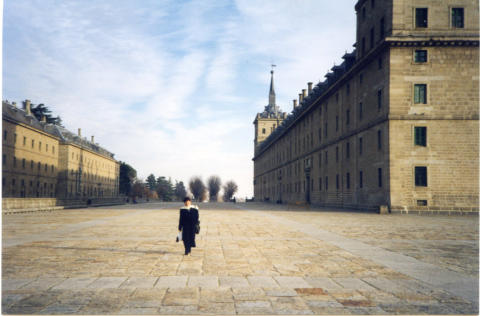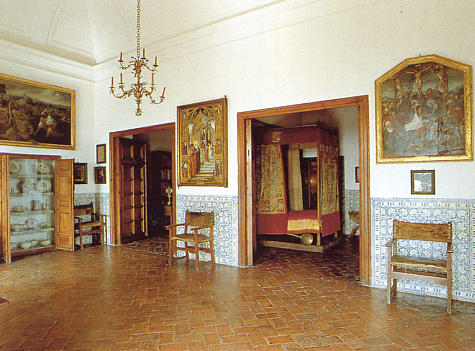A few brief impressions after visit to El Palacio de El Escorial (on a day in winter, hence the lack of 'real' tourists):
El Escorial is the palace built by Philip II of Spain and is situated about an hour's train ride to the north-west of Madrid and one winter's day we decided to go and do the 'touristy' thing and look around but this is not a tourist guide to the building, it is more of an impression of what we found there.
If you want the history etc then full details are here (in Spanish)
http://es.wikipedia.org/wiki/Monasterio_de_San_Lorenzo_de_El_Escorial
and here (in English)
http://en.wikipedia.org/wiki/El_Escorial
The palace itself is huge and very impressive in every way; here you can see the scale of it:
First thing you see inside is a small display of architectural artefacts including some of the original drawings as well as a scale model of the wooden cranes used in the construction. It is easy to forget that before the industrial revolution everything had to be done by hand and lifting heavy stone blocks required a combination of hard labour and ingenuity.
The royal apartments are surprisingly small. The King's bedchamber is centrally placed within the building and very cleverly designed; from his bed he could see the surrounding countryside through two balconied windows and looking the other way he could see through his private chapel to the Basilica's high altar.
and, in my view, is much more impressive than the other frescos elsewhere in the building.
The Pinacoteca (art gallery) is divided into four rooms and displays works from the 15th, 16th and 17th century including this wonderful masterpiece by Rogier van der Weyden:
 |
| http://www.artbible.info/art/large/658.html |
When I saw this painting I almost fell over because of the disorienting use of colour - red, which is a colour that comes forward, is used as a background and the two foreground figures (and two others on separate panels at the sides of the main picture) are bluish grey which is a receding, background colour. It appears as though there are four statues standing in front of the painting. The effect is startling and is not seen to quite the same effect in reproduction. You need to go and see it for yourself but don't blame me if you fall over; you have been warned!
Down in the Pantheon are the tombs of Spanish kings and various notable figures of Spain's history including the famous Don Juan (http://en.wikipedia.org/wiki/John_of_Austria) - the most handsome man in the world (so I am told!)
Part of the building is still used as a school and you have to admit that is one magnificent playground!
Shortly after this picture was taken an elderly tourist decided to join in, just to show these small boys how.... and with a muttered 'Dios mio' my compañera headed for the chapel to beg forgiveness for my foolish ways.
and only 6½ leagues and 1191 yards back to Madrid:
The return journey was my first and (so far) only ride on a double-decker train. Why don't we have things like that in this country?










